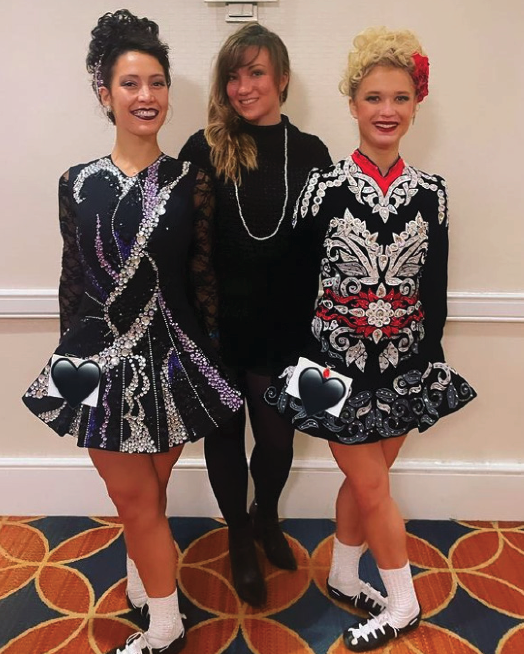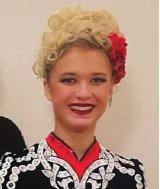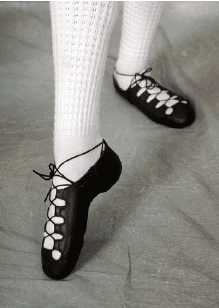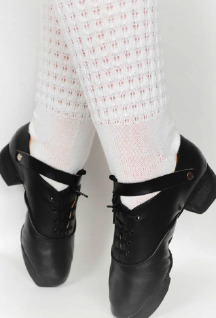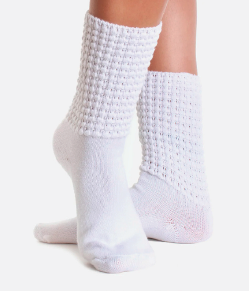A guide to competitions
In Irish dance, a ‘feis’ (Gaelic for festival; plural: feiseanna) is a local competition. There are plenty of feiseanna held throughout the year. Dancing at feiseanna is a lot of fun and a great experience for goal setting, stage presence, and making new friends. It is a brave new world that sometimes they can be a little confusing, especially for new dancers. This Competition Guide can help you all decipher it all!
Please note - the requirements and recommendations in this guide are for current ODA dancers participating in CLRG-sanctioned events. These rules may vary for different dance schools and dance organizations.
Feisanna
To perform at a feis, you must be currently taking classes with a registered CLRG teacher - Ms. Erin will let you know when you are ready to compete! There are seven levels of competition at feisanna, and the rules, costumes, and dances performed will vary depending on a dancer’s age and level.
Pre-Beginner (First Feis/Tir Na Nog)
For dancers 6 and under who have taken less than a year of dance classes with ODA. This is an introductory level that’s just for fun and to experience dancing on stage - every dancer will receive an award, usually given out by the judge, and family members are encouraged to clap along and take lots of photos. Appropriate for our littlest dancers who are still learning the basics of dance, but want to get on stage and have fun!
Beginner
For dancers who have taken less than a year of dance classes with ODA. Beginner level is more official - dancers will be expected to handle being on stage by themselves, with a stage helper to count them in and guide them should they get confused. Dancers may perform up to three different dances (Reel, Light Jig and Slip Jig), which means they can win up to three medals! In Beginner, the judge will generally ensure that every dancer will receive at least one medal.
Advanced Beginner
For dancers who have taken more than a year of dance classes with ODA. Dancers will still compete in the three light shoe dances (Reel, Light Jig and Slip Jig), but medals are no longer guaranteed. This can be a tough adjustment, but it’s important to recognize the value of hard work towards earning higher rewards. Dancers must medal in every dance in order to advance to the next level.
Novice
For dancers who have medaled in all three light shoe dances in Advanced Beginner. Dancers in Novice will begin to compete hard shoe dances (Treble Jig and Hornpipe), which means they can be entered in up to five dances. Dancers must win 1st place in every dance in order to advance to the next level.
Prizewinner
For dancers who have placed 1st in all dances in Novice. Dancers in Prizewinner will no longer compete the Light Jig, which means they can be entered in four dances. Dancers must win 1st place in every dance in order to advance to the Championships level.
Preliminary Championships
This is the first Championship level, and as such the competition format changes. Each feis will consist of one competition with two rounds; a light round and a heavy round. Depending on age your dancer will either dance their Reel and Hornpipe, or their Slip Jig and Treble Jig. When your dancer is ready for this level we will help you know which dances they will be competing in. Dancers will also begin to learn their “set dance,” a personalized hard-shoe dance that is performed as a solo at some competitions and at Majors. Dancers need to achieve THREE 1st place wins in Preliminary Championship to advance to Open Championship.
Open Championships
This is the final level achieved at feisanna, and an astounding accomplishment in itself! Each competition will have three rounds; a light round and a heavy round and a set round. Depending on age your dancer will either dance their Reel and Hornpipe, or their Slip Jig and Treble Jig, plus their set dance. Dancers at this level will focus on competing at Majors such as the Oireachtas, North American Nationals, and international competitions.
Advancing from one level to the next is different for every dancer - for some it may be easy, and for some levels it may take a long time! Irish dancing is very subjective and each competition is a unique experience with different dancers, judges, musicians and stage conditions. Placements will fluctuate from feis to feis. Please do not get discouraged should your dancer not place or only receive one medal in one round; Irish dance is a great sport to teach the importance of hard work, practice, consistency and subjectivity. The most important thing to us is that your dancers have FUN! There are enough feiseanna in the area that should you not place in one, the next one is right around the corner; you’ll always have another opportunity to improve!
Major Competitions (Majors)
A Major is a large competition for advanced/Championship dancers - there are several throughout the year, both in America and around the world.
Oireachtas (The O, MARO)
Thanksgiving Weekend, Philadelphia
Pronounce O-ROCK-TAS, this is the primary major competition, the regional championship. Each region has their own Oireachtas - ours is the Mid-Atlantic Region Oireachtas, held in Philadelphia each year on Thanksgiving weekend. The Oireachtas is the primary qualifying event for the World Championships, and as such is held in high regard. Dancers in Prelim and Open may compete in Championships and Ceili (team) competitions. Dancers in Advanced Beginner, Novice or Prizewinner may also be invited to participate in Ceili competitions, and may be eligible to compete in the Traditional Set competition. Competing as a team and/or traditional set dancer is an excellent way to experience the Oireachtas as a younger dancer, and get inspired to reach the Championship level and make it to “the big stage.”
North American Irish Dance Championships (The Nationals, North American Nationals, NAIDC, NANs)
First Week of July, Location Rotates
The North American Irish Dance Championships is held July 4th weekend every year and is hosted throughout North America - 2023 will be held in Nashville, TN. Unlike other majors, this event is open to Irish dancers from all countries, so dancers will be competing with the best from America, Canada, Ireland, England and much more. Dancers must qualify at their regional Oireachtas OR be in Open Championships to compete. The Nationals is a secondary qualifier for the World Championships, meaning that North American dancers can also qualify here, although they MUST compete at their regional Oireachtas to hold their qualification status.
Oireachtas Rince na Cruinne - The World Irish Dancing Championships
Easter Week
The most prestigious event of all - only the best of the best get to compete at the Worlds. Dancers may qualify for the World Championships only by achieving a high placement at their Oireachtas or National Championships in the year prior. This event is held on Easter Week each year and the hosting city rotates, the 2020 World Championships will be held in Dublin, Ireland.
Oireachtas Rince na hEirann - All Ireland Championships
Mid-Late February, Killarney
Ireland’s national competition, which is open to all competitors (no qualifications required, although only dancers in Open Championship should attend). Nearly as difficult as the Worlds, a great way to get use to overseas competitions.
The All Scotland Championships
Early October, Glasgow
Scotland’s national competition, which is open to all competitor.
The Great Britain Championships
Mid-Late October , London
Britain’s national competition, which is open to all competitors.
What to Wear
Pre-Beginner (First Feis)/Beginner/Advanced Beginner
In these levels dancers can wear one of two options:
1. An ODA skirt with a black leotard and white poodle socks.
2. Plain black button up shirt tucked into plain black pants, with a yellow bow tie and/or suspenders.
ODA School Dress - for dancers in Advanced Beginner & up
In these levels dancers can choose to upgrade to the ODA school dress with black leotard (sleeves are required in competition, so leotard should go underneath the dress. This will also help keep the dress clean!). Dancers may also continue to wear pants if they have chosen that option.
Novice/Prizewinner
At this level, while you continue to wear the school costume, we will begin the excitement of looking for a solo dress. These are the embroidered, sparkly, one-of-a-kind dresses you will have seen at the various feiseanna you have attended. Solo dresses can be custom made for your dancer, but we recommend finding a pre-loved dress for your first one as they can be on the expensive side. When you get to this stage we will provide you with a list of websites and Facebook groups to search for dresses and you can always look at each feis to see what is for sale. You will need to consult with Miss Erin before purchasing a solo dress so that we can use our experience to help you determine if it is a good deal, of good quality and style, and a nice fit for your dancer.
Dancers who wish to wear pants may continue to wear a plain black button up shirt and pants, but can begin to look into the more decorated vests/waistcoats. These are usually custom made and paired with a tie of a matching color and a button up shirt underneath of any complementary color. We will consult with you at this stage to see what ‘look’ is best for your dancer!
Preliminary Championships/Open Championships
In all Championship levels, dancers will wear a solo dress and/or a waistcoat/vest. School costumes are not permitted on any dancer in this level. However, should you be between dresses, the black leotard and a plain black skirt (no ODA logos) is allowed.
Even when your dancer graduates to a solo dress, they will be in need of their school costume as we will continue to wear them at performances throughout the year. Also, should your dancer compete in a ceili or team competition, they will be required to wear their school costume as solo dresses are prohibited in team events as per feis rules.
Hair
We like to keep it more natural and simple here! This is why we have Pre-Beginner up through Novice levels wear half up, half down (or neatly pinned back) to compete and perform. Your dancer should wear a yellow bow clipped in just above the top of their pony tail. Any dancer with short hair should have it neatly combed and hair-sprayed/gelled to keep out of their face.
Wigs will be required once you purchase a solo dress in the Novice/Prizewinner level. Natural hair doesn’t compliment the elaborate solo dresses and wigs are very helpful in that your dancers hair will look perfect every time they put it on! Just like solo dresses, please consult with Ms. Erin before you purchase a wig. These are an investment and there are a lot of varieties to choose from. We like to consult with you and your dancer to create the best ‘look’ for them! Some dancers look best in a full wig, some look great in a bun wig; each dancer is different and it can be fun to create your individual look!
Examples of both Bun Wig and Full Wig options for dancers in Novice and beyond.
Make Up/Tanner
There is no need for any make up until your dancer gets their solo dress or is over the age of 12. Then we prefer a more natural look. A good guideline would be blush, eyeliner, mascara, lipstick and some natural eyeshadow. As per feis rules there should be no make up on any dancer 10 or under.
As for tanner, you may have noticed dancers with very orange/tan legs walking around! This is also not necessary until your dancer has a solo dress or is in the Prizewinner level. The reasoning behind the tan legs is that stage lights are very bright and tend to wash out the dancers; the tan allows the dancers legs to stand out and the judges are better able to see the fancy footwork. When you need to tan we can recommend some good brands for you to use. Neutrogena has a great tanning foam that can be put on in a few coats, isn’t too orange, and washes off easily with water!
Socks & Shoes
Soft shoes: If you are in the ‘Pre-Beginner’ category, you can wear the black soft ballet slippers you may currently wear at class. Once you hit the Beginner category, however, you will need to purchase ‘ghillies’ (Irish dance soft shoes). We recommend the brand ‘Fay’s’ which usually have a vendor at each feis but you can also get them online. Dancers who wear pants in competition can wear ghillies or black jazz shoes. Please note that all black soft shoes are required. They do sell colored ones but they are banned from competitions so should you purchase them they would only be allowed to be worn for practice at home. Shoes (both ghillies and jazz) should fit the foot snugly as they are leather and stretch out with constant wear. When shoes are too big/floppy your dancer could easily trip on them and not be able to complete their moves properly and safely. Don’t forget to check with Miss Erin to see if there are any ‘Pre-Loved’ shoes available before you purchase new ones!
Hard Shoes: Once your dancer starts to learn their hard shoe dances they will need them for practice, performances and competition. Again we recommend the brand ‘Fay’s Shoes’ however there are plenty of other brands to choose from and you can shop around to find cheap prices. Please note that once again all black leather is required. You may see other dancers with white leather or tape on their shoes. This is not something ODA dancers need to do unless you are in the Championship level and we can discuss it with your ‘look’ then. You may also see other dancers with buckles on their shoes; this is something to be considered when your dancer gets a solo dress! Hard shoes should also fit the foot snugly as they are leather and stretch out with constant wear. When shoes are too big/floppy your dancer could easily trip on them and not be able to complete their moves properly and safely.
Poodle Socks: we know there are a lot of options for poodle socks out there. Tall, short, sparkly, tie dyed etc. White socks are required for competition; colored socks are only allowed for practice. As for sock height, a good rule of thumb is to have the sock to come up to the base of the calf muscle. Sparkly socks are fine for both competition and practice in the Pre-Beginner-Novice levels however when you get your solo dress we will discuss it with each dancer’s individual ‘look’. Please try to find socks with more subtle, smaller stones versus the bigger ones that tend to look like polka dots on stage! Also note that once your dancer reaches the Novice level they should be using roll on ‘Sock Glue’ to keep them up and at an even height on their legs. This can be purchased at any feis, is safe to use, and can be easily washed off with water.
Dancers wearing pants should wear tall, plain black socks.
Registering for a feis and receiving your marks
Most of the feiseanna you sign up for will be through an online platform like feisweb.com or quickfeis.com. Once you create an account, you can keep track of what feises you’re entered for and what feises you have been to in the past. This website also has an area on it where you can find your dancers scores and marks from each feis they go to. Here you will find the score, their ranking and any comments the judge may have given for each dance. These are extraordinarily helpful both to your dancer and to us for honing in on the specific things we need to work on and to make sure we are all on the same track. If you wanted to screenshot your dancers marks and email them to us that would be great! You can also print them out and bring them to class. Should you forget, no problem at all. We know what we need to work on in classes and most of the time the judges write comments on things we are already working on with your dancer; it just helps solidify to your dancer ways to improve!
What Comes Next?
It’s time to compete! If you’re ready to feis, talk to Ms. Erin after class to determine what your dancer needs to register for their first competiton. We do not require competing, it is a fun and truly unique aspect of Irish dance that can build incredible friendships and memories of dance for years to come!






